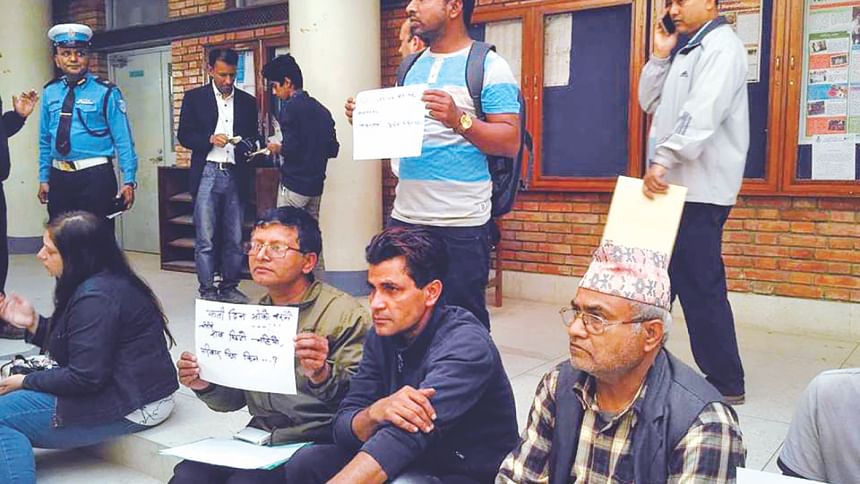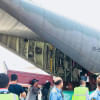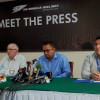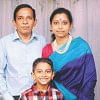Test of patience after shock

A flurry of activity outside the main gate of Tribhuvan University Teaching Hospital alerted journalists to something happening soon. Within moments, an ambulance drove towards the forensic department and a few worried people -- relatives of the Monday's air crash victims -- hustled hoping to have a glimpse of their departed loved ones.
But it was not one of the crash victims; it was someone who passed away suffering a cardiac arrest.
Everyone stepped back. A TV crew set up a camera and a newscaster began talking about the tragedy and a press conference about to take place in minutes.
There was no sign of any of the bodies of the victims. Their relatives were getting impatient.
Inside the Institute of Medicine, housed in the hospital, Basimah Saifullah was fuming. The sister of cabin crew member KHM Shafey Hussain, she did not even get time to express her grief. She was too busy looking for her brother.
"No one has updated me on anything. They won't let me see the body of my own brother. I had to run around and be confirmed that my brother is no more,” she said.
Basimah was in the shower when she heard her sister-in-law crying. Rushing out, she heard the US-Bangla plane had just crashed. The news sent shock waves through the entire family. Her maternal grandfather passed away hearing that Shafey had possibly died. “My mother lost her son and father on the same day and I am stuck here trying to get my brother's body. No one is helping us.”
Talking to The Daily Star yesterday, she alleged that her brother never wanted to go to Kathmandu and be on that ill-fated flight.
This newspaper could not verify the claim.
“I had to go to the hospitals myself and investigate whether my brother was alive. They say his body is unrecognisable but others have seen it. He is wearing his ID card!” Basimah added.
She was not the only one who was having the trouble. Jibon, whose uncle Matiur Rahman died in the accident, had the same complaint.
“Why am I here? I only brought one pair of clothes because they said we would have to identify the body and take it back home. What is my embassy doing? Why is the media not talking to us?”
Jibon said while they had officers around them no one was really taking any responsibility.
The Daily Star has learnt that despite its limited resources, Nepal was trying its best to deal with the issue.
TWO MORE DAYS
Imran Asif, the chief executive officer of US-Bangla Airlines, soon arrived for the awaited press conference inside the institute. He spent around 20 minutes speaking to the reporters. “We aren't just working with the Bangladeshis but with people of all nationalities. It's hard to identify who is who and according to the international laws, we can't let the relatives see the victims until the identification process is complete.
“Doctors have informed us that the test will take a few more days and that a DNA test may not be necessary. Once the bodies are identified and the FIR is done, we can send the bodies back.”
He said the relatives may have to wait for two more days, pointing out that a lot of factors were involved in the process. He added that they themselves had not seen the bodies.
Asked why the name of Nabila, another cabin crew member, was not on the passengers' list, he claimed that the airlines did not prepare that list.
“We had a passenger called Shahreen Ahmed and as words spread some believe that Sharmin Akhter Nabila was the same person.”
Relatives wanted to take some of the injured elsewhere for treatment, he said, adding that they could do that once they got the doctor's approval. He pointed to the case of passenger Rezwanul Haque who was being sent to Singapore for further treatment.
MINISTER'S WHIRLWIND VISIT
Right after the US-Bangla press conference, journalists came to know that Civil Aviation and Tourism Minister AKM Shajahan Kamal was on his way to the hospital. The relatives of the victims started waiting, hoping to finally have a chance to talk about their grievances. That, however, was not to be.
Shahjahan arrived at the hospital on a whirlwind visit that lasted around an hour. During that time, he visited a few departments of the hospital. He was flanked by a number of armed guards, representatives from US-Bangla airlines and Ambassador of Bangladesh to Nepal Mashfee Binte Shams.
Seeing him, the relatives of the victims gathered and tried to draw his attention to some placards that read “Where are the bodies?”
The minister entered the institute building and went up the stairs. After around 40 minutes, he slowly got down, holding the hand of one of his team members. Later, he went straight to the forensic department, which is on the ground floor.
Getting out from there, he went to the main gate of the building, without talking to the relatives.
He stopped in front of the hospital gate and told journalists that he had spoken to the prime minister and “everything” would be done within two days.
All the problems would be solved, he promised.
The relatives, however, wondered how that would be possible since he did not even know their problems.
An unidentified man tried to tell a member of the minister's team that it was courtesy to meet the relatives. He, however, could not make it past the swarm of journalists. When Basimah and Jibon asked another member of the minister's entourage why he wasn't meeting them, the team member told the two not to bother since the minister was “very old”.
As the minister left with his promise, the relatives stayed back once again not knowing what to do. They had not planned for a long trip. They filled out all the forms they were given. But they still did not know when they would see the bodies of their loved ones. They had no news for their family waiting back home. Tomorrow would be another day, although not a very different one.

 For all latest news, follow The Daily Star's Google News channel.
For all latest news, follow The Daily Star's Google News channel. 








Comments